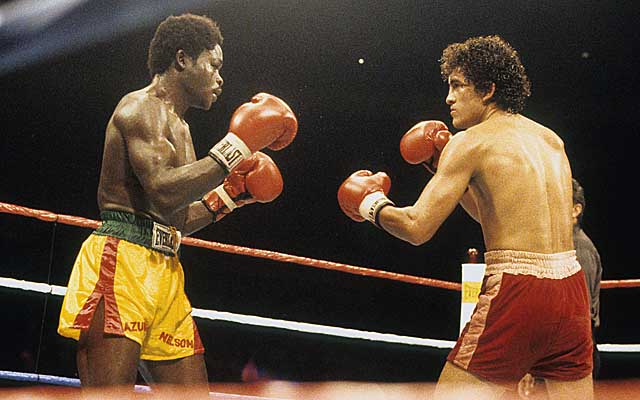July 12, 1986: Holyfield vs Qawi I
Not often do you see fighters who so clearly love the sheer brutality of boxing the way Dwight Muhammad Qawi once did. Fighters who smile when they take punches. Fighters who literally and figuratively shrug off with a laugh clean shots that are, to anyone else, anything but a laughing matter. Qawi, formerly Dwight Braxton, perfectly exemplified his moniker of “The Camden Buzzsaw” as, at only 5’7″, he mowed down much bigger men with ruthless efficiency while exhibiting an unmistakable zeal for combat.
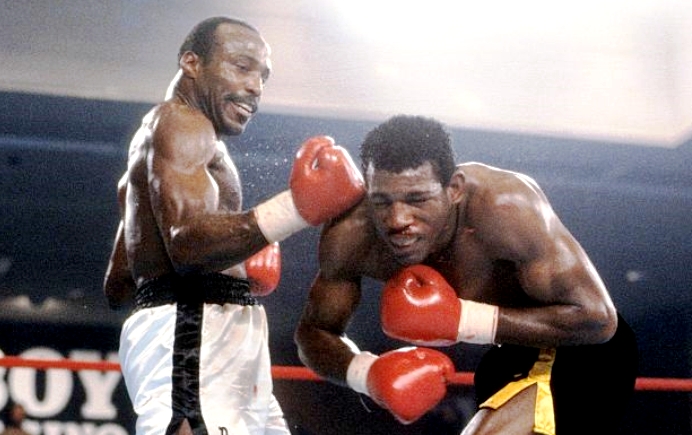
Qawi’s instincts towards war had a well-defined story leading up to his boxing career. Raised on the hard streets of Camden, New Jersey, a 19-year-old Braxton was sent to Rahway State Prison for armed robbery. There, he learned to box under the mentorship of fellow inmate and former light-heavyweight contender, James Scott. Following his release in 1978, and with no amateur experience, he turned pro and within just three years “The Camden Buzzsaw” would take the WBC light heavyweight championship belt from future Hall of Famer Matthew Saad Muhammad, in the process dishing out a vicious battering to “Miracle Matthew.”
Qawi made three successful defenses of his title, including stoppage wins over Jerry “The Bull” Martin and Eddie Davis, before losing on points to Michael Spinks in a high-profile unification bout. Two years later, Qawi rebounded by adding a WBA cruiserweight (then junior-heavyweight) title belt to his dossier. And as fate would have it, the second defense of his championship came against Olympian and future legend, Evander Holyfield.
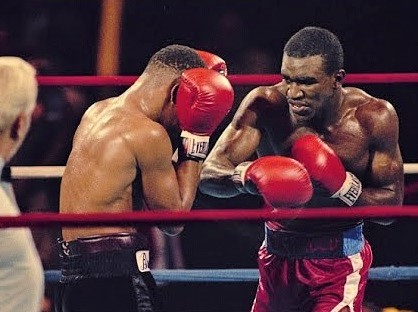
While Holyfield also faced considerable hardship growing up in the housing projects of southeast Atlanta, Evander enjoyed an extensive amateur career that culminated with him representing the US in the 1984 Olympics. However, he was deprived of his Olympic dreams when he was controversially disqualified for hitting on a “break” command hardly anyone at ringside even heard. Despite the setback he was still considered among the cream of the crop on a US Olympic team that took nine out of twelve possible gold medals. And indeed it was Holyfield, in just his second year as a pro, who became the first member of that Olympic team to challenge for a world title.

A Holyfield vs Qawi match-up not only represented a massive leap in class for Evander in just his twelfth pro bout, but also an enormous risk for the young prospect, considering Qawi’s ruthless approach, strength, and physicality. Holyfield, having never gone past round eight in his short career, was faced with having to keep at bay a relentless, Henry Armstrong-like perpetual-motion machine for fifteen rounds, with only his hometown fans at Atlanta’s Omni Arena to support him. Talk about a daunting task.
In many ways, Holyfield vs Qawi I would prove to be reminiscent of “The Thrilla In Manila”, an Ali vs Frazier type war for the cruiserweight division. Like Joe Frazier, Qawi was at a significant disadvantage in terms of height and reach and was thus forced to walk through repeated crisp combinations from one of the most accurate sharpshooters in recent boxing history just to get into punching range. But while Holyfield held clear advantages in terms of youth, size, and natural talent, like Muhammad Ali in Manila a decade before, he was still in tough as he struggled against a determined and teak tough warrior who refused to take a backwards step, regardless of what “The Real Deal” connected with.
In the first two rounds, Evander boxed with discipline and kept Qawi at bay, but his innate warrior mentality got the better of him in the third when he met the champion head on with a barrage of vicious shots. The match evolved into trench warfare, as Holyfield connected with the cleaner punches while Qawi got home with the heavier shots. “The Camden Buzzsaw” was also ripping hurtful blows to Holyfield’s body, a smart investment which would take a toll on the 23-year-old challenger.

In round four, Qawi successfully cornered Holyfield and began to score more regularly, eventually hurting the challenger with a right hand as Evander attempted to pivot off the ropes. For much of the middle rounds, Holyfield’s chances of winning his first world title looked increasingly dim. While he was still winning rounds, the challenger seemed to be fighting to reach the finish line, while Qawi appeared to be just getting started.
But responding to the urging of his trainer, Lou Duva, Holyfield came alive in round eight with a sudden burst of energy to put Qawi on the receiving end of at least twelve unanswered punches, and sending a clear message that the challenger had plenty left in the tank. It’s amazing to think that in Holyfield’s first time being extended past the eighth he was able to maintain such a hellish pace against a fighter of Qawi’s caliber. Indeed, it appeared as though Holyfield had more energy in the latter rounds than he did in the middle of the fight.
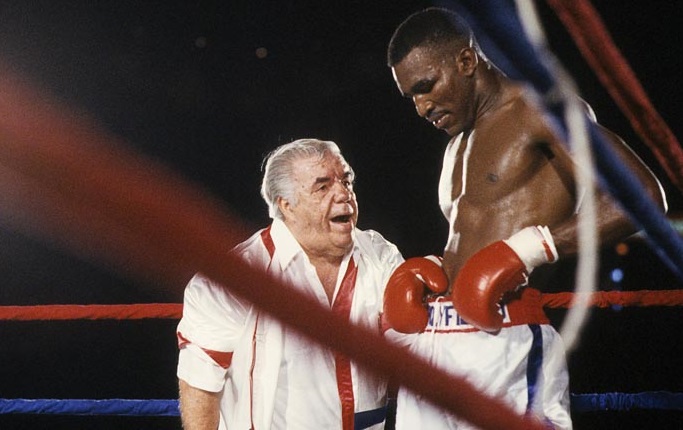
Round thirteen epitomized the reason Ring Magazine would later rank Holyfield vs Qawi as the 46th greatest title fight in the long history of pugilism. “The Real Deal” opened it with a fusillade of punches which looked like they’d never end, but then Qawi was right on top of him like a rabid dog looking to even the score. Holyfield punctuated the round with a picturesque right uppercut-left hook-right hand combination that had the champion’s head looking like a speed bag, to which Qawi responded by dropping his hands as if to goad Evander further into his masochistic game. How Qawi survived the round is anyone’s guess, but sure enough “The Camden Buzzsaw” showed no reluctance to press the action in the closing six minutes.
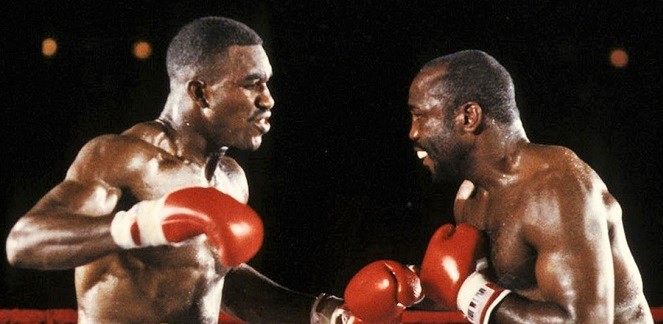
If round thirteen was the finale of a truly great fight, round fifteen was the encore. Both gladiators laid it all on the line in the final three minutes and after the bell rang, Holyfield was credited with throwing a total of 1290 punches, with nearly half landing. Qawi scored 55 percent of his 1018 punches in his own right, but two of the three judges gave Holyfield the nod and the cruiserweight championship of the world in just his second year as a professional. In any case, the bottom line is that Holyfield vs Qawi is one of the best fifteen round fights of recent boxing history.
Soon after the judges’ decision was announced, Evander complained of headaches and he was admitted to hospital where the new champion was given nine quarts of intravenous fluid to combat a kidney ailment that stemmed from a state of severe dehydration. Years later, Evander claimed to have lost fifteen pounds during the Qawi fight and that he nearly quit the sport as a result.

However, it’s not unlike Evander Holyfield to emerge from a life-and-death ring struggle as a better boxer, as he would later demonstrate by moving up to become heavyweight champion and in his famous trilogy against Riddick Bowe in the 1990s. Qawi, on the other hand, would never truly be the same, getting blasted out by Holyfield in four rounds in their rematch and then suffering defeats to George Foreman and Robert Daniels in the years that followed.
But while “The Camden Buzzsaw” and “Commander Evander” carried the cruiserweight championship for only a combined three years, the two warriors forever put the fledgling weight class on the map with one of the greatest back-and-forth donnybrooks of the modern era. Indeed, a strong case can be made that Holyfield vs Qawi I remains the most grueling and action-packed fight in all of cruiserweight history. — Alden Chodash





